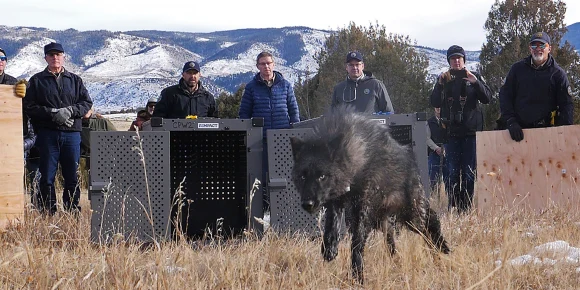The pack formed after 10 of the predators from Oregon were released in December over bitter opposition from livestock groups.
Colorado wildlife officials announced Monday that they have captured and plan to relocate five members of the first wolf pack formed under the state’s wolf reintroduction program.
However, a sixth wolf, the pack’s adult male, did not survive captivity due to unrelated injuries. This wolf had been involved in frequent livestock attacks, and officials indicated that it would have been kept in captivity had it survived.
The Copper Creek pack’s capture marks a significant challenge in the early stages of a voter-approved initiative aimed at restoring wolves to Colorado, where they were previously eradicated through poisoning, trapping, and hunting.
The pack had formed after 10 wolves from Oregon were released in December, amid opposition from livestock groups. This effort to capture the pack diverged from Colorado’s wolf management plan, which states that relocation has limited value and could lead to further issues if wolves continue to attack livestock in new areas. The plan prioritizes non-lethal methods, such as using range riders or deterrents to scare off wolves, and allows lethal action only if necessary to prevent continued livestock losses.
State officials confirmed that the female wolf and her four pups were not involved in the livestock killings in Grant County. Killing the pack was ruled out, as doing so would have been a significant setback for the still-developing reintroduction effort.
“This was an incredibly unique situation from the outset, requiring an equally unique approach,” said Jeff Davis, Director of Colorado Parks and Wildlife. “Ensuring these pups have a second chance in the wild was a critical part of our response.”
Plans for releasing the remainder of the pack will be determined once the pups mature and are capable of hunting independently, officials added.
Ranching groups have called for the pack’s removal, arguing that relocating them simply transfers the problem elsewhere. “We know these wolves have been part of the killings, even if CPW says otherwise,” said Tim Ritschard, president of the Middle Park Stockgrowers Association. “In a few years, we’ll be dealing with this all over again when the pups are older.”
Meanwhile, livestock owners whose animals are killed by wolves can receive compensation from the state, with payments capped at $15,000 per animal.
Wildlife advocates, however, expressed concern over relocating the wolves, particularly the pups, which could face survival challenges. They urged more efforts to prevent livestock attacks, including the use of electric fencing.
Michael Saul from Defenders of Wildlife called it “the least-bad outcome from a difficult situation,” emphasizing the need for stricter rules requiring that all non-lethal options be exhausted before relocation is considered.
In other parts of the U.S., such as the northern Rocky Mountains and the Great Lakes region, wildlife officials frequently kill wolves involved in livestock attacks. These regions have larger wolf populations, making selective removal less impactful.
Wolf reintroduction in Colorado was narrowly approved by voters in 2020, and wildlife officials plan to release an additional 30 to 50 wolves in the coming years. Some wolves have also naturally wandered into the state from neighboring Wyoming.
Supporters of the reintroduction believe the predators will help restore balance to the local ecosystem.
